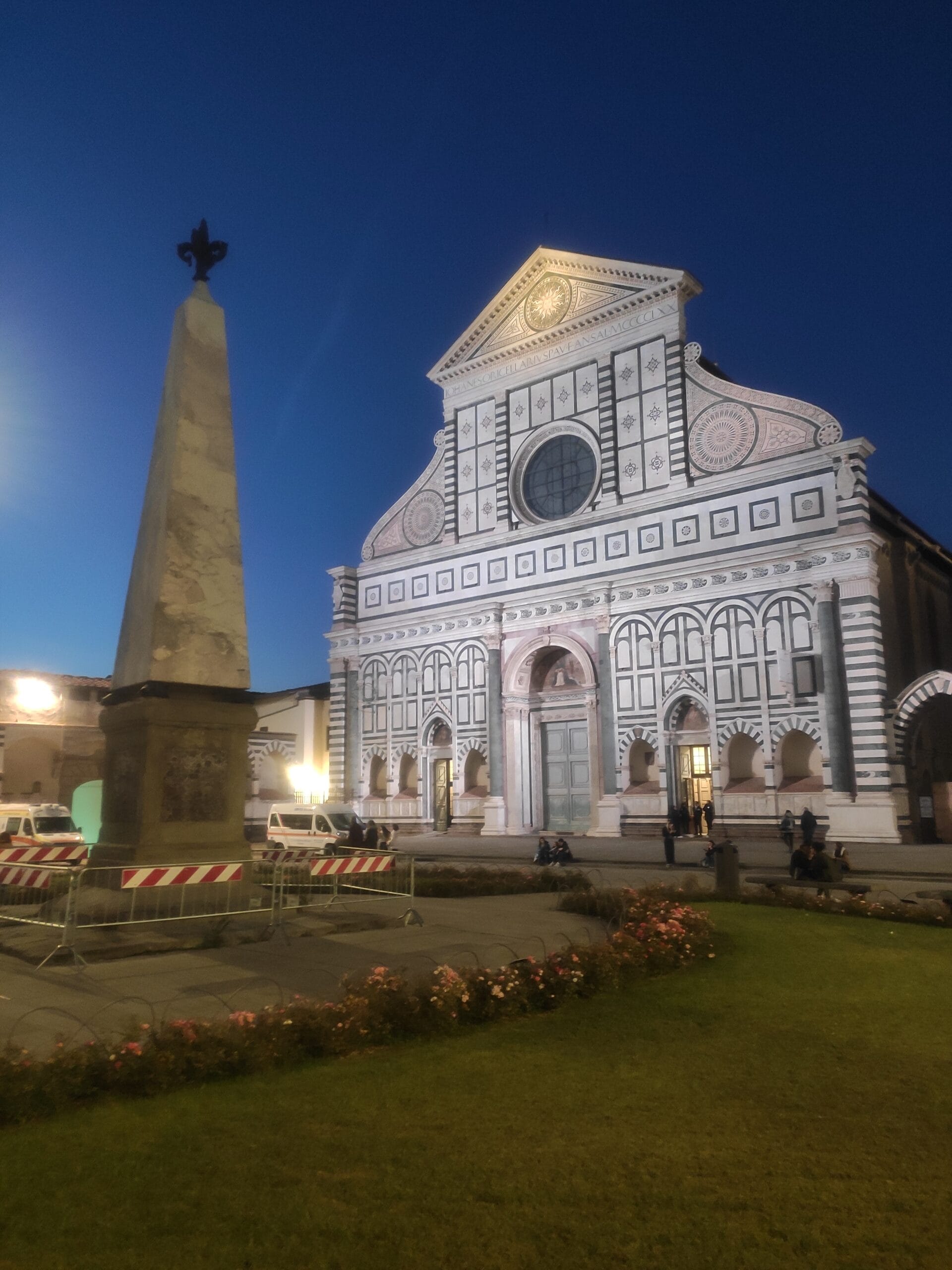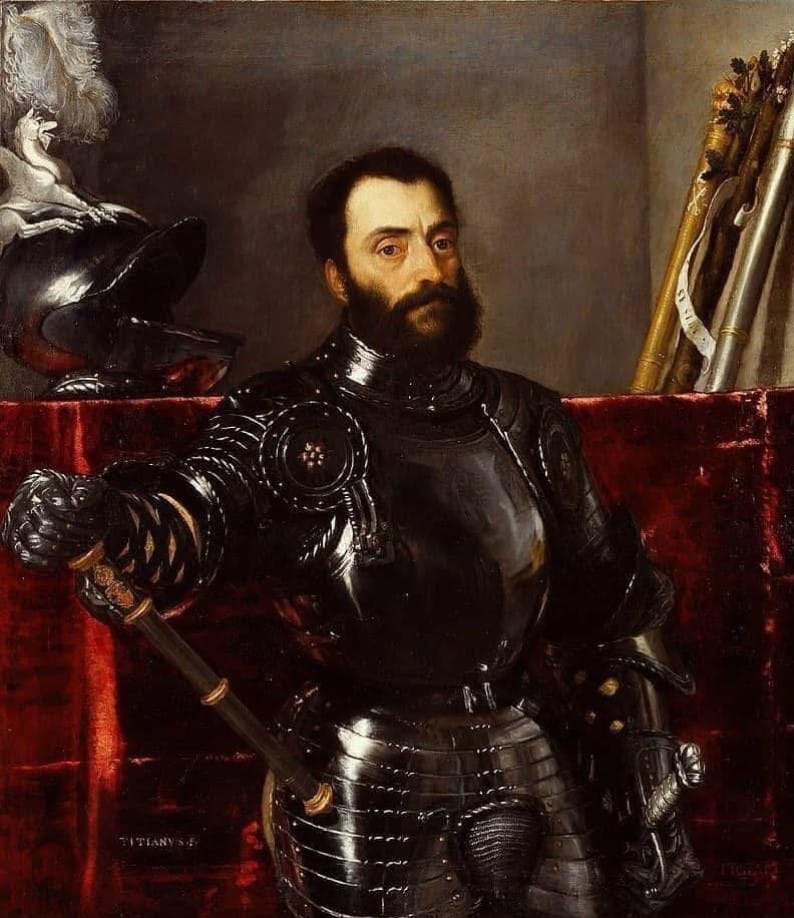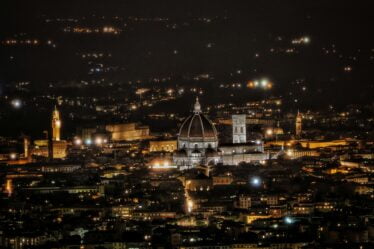

Power, Armor, Honor, Legacy—this phrase perfectly captures the life and image of Francesco Maria della Rovere, one of the most legendary military commanders of the Italian Renaissance. From noble lineage to deadly rivalries, from battlefield glory to mysterious death, his story is woven into the rich tapestry of 16th-century Italy.
A Commander in Full Glory
Wearing his most magnificent armor, Francesco Maria della Rovere poses with pride in the portrait painted by Titian. The portrait, titled Portrait of Francesco Maria della Rovere, Duke of Urbino, (1536–1537), is now housed at the Uffizi Gallery in Florence.
In his right hand, the Duke holds the Commander’s baton, a symbol of his authority conferred by the Republic of Venice. Resting on a red velvet-covered table, an exquisite helmet topped with a dragon evokes his family’s connection with the House of Aragon. On the opposite side, two scepters lean against the wall: one golden, adorned with the Petrine keys, granted by the Papal States, signifying his title as Gonfaloniere and Captain General of the Church; the other silver, gifted by the Duchy of Florence.
Between these emblems lies an oak branch (in Italian, rovere), an unmistakable reference to the family name. This striking composition encapsulates Power, Armor, Honor, Legacy—the essence of the Duke’s political and martial stature.
Early Life and Family Ties
Born in Senigallia on March 25, 1490, Francesco Maria was the son of Giovanni della Rovere, brother of Cardinal Giuliano, the future Pope Julius II. Even as a youth, he was known for his strength and temperament.
After the early death of his father, the 17-year-old Francesco Maria committed a shocking double murder: he killed his sister’s suitor and the servant believed to have enabled the affair. Thanks to the influence of his powerful uncle, the incident was officially dismissed as an unfortunate accident. Nevertheless, this event would mark his life—and legacy.
Moreover, he was the maternal nephew of Guidobaldo da Montefeltro, Duke of Urbino. Without heirs and physically infirm, Guidobaldo formally adopted Francesco Maria, naming him his successor.
Marriage and Military Campaigns
The year 1508 was a turning point. Not only did he inherit the Duchy of Urbino after Guidobaldo’s death, but he also met his future wife, Eleonora Gonzaga, daughter of Francesco II of Mantua and the illustrious Isabella d’Este. Their marriage had been arranged three years earlier, but their actual union was delayed due to the Duke’s military obligations.
Indeed, Francesco Maria soon joined the War of the League of Cambrai, leading papal troops against Venice and Ferrara. This period defined the beginning of his career as one of the most sought-after condottieri of his time. Again, Power, Armor, Honor, Legacy echoed in his every step.
Tensions with the Papacy
Despite his devotion to Pope Julius II, Francesco Maria caused him heartbreak in 1511 by murdering Cardinal Alidosi, administrator of Bologna and the Pope’s close confidant. It was allegedly a matter of precedence and insult. Julius II, devastated, reportedly shed “the only true tears of his life.”
Although summoned to Rome and placed under semi-arrest, he was tried by a commission led by Cardinal de’ Medici, who ultimately absolved him. However, his fortune would shift dramatically when the same Cardinal de’ Medici became Pope Leo X.
Exile and Return to Power
In 1516, Leo X stripped him of the Duchy of Urbino, bestowing it upon his own nephew, Lorenzo de’ Medici. However, Lorenzo’s early death in 1519 and the Pope’s own demise in 1521 cleared the way for Francesco Maria to reclaim what was rightfully his. With this dramatic return, Power, Armor, Honor, Legacy surged again in his favor.
Back in power, he resumed a brilliant military career, defending papal and imperial interests and earning widespread respect.
Legacy and Final Years
In his later years, Francesco Maria focused on enriching his city, Urbino, following in the footsteps of his famous predecessor, Federico da Montefeltro, as a patron of the arts and architecture.
However, his life ended mysteriously on October 20, 1538, in Pesaro. Rumors of poisoning swirled, though no definitive culprit was ever identified. The truth remains lost in history, as does the full meaning behind his death.
Today, his portrait by Titian, at the Uffizi Gallery, remains a vivid symbol of Power, Armor, Honor, Legacy, and an enduring window into Renaissance power, politics, and pride.



